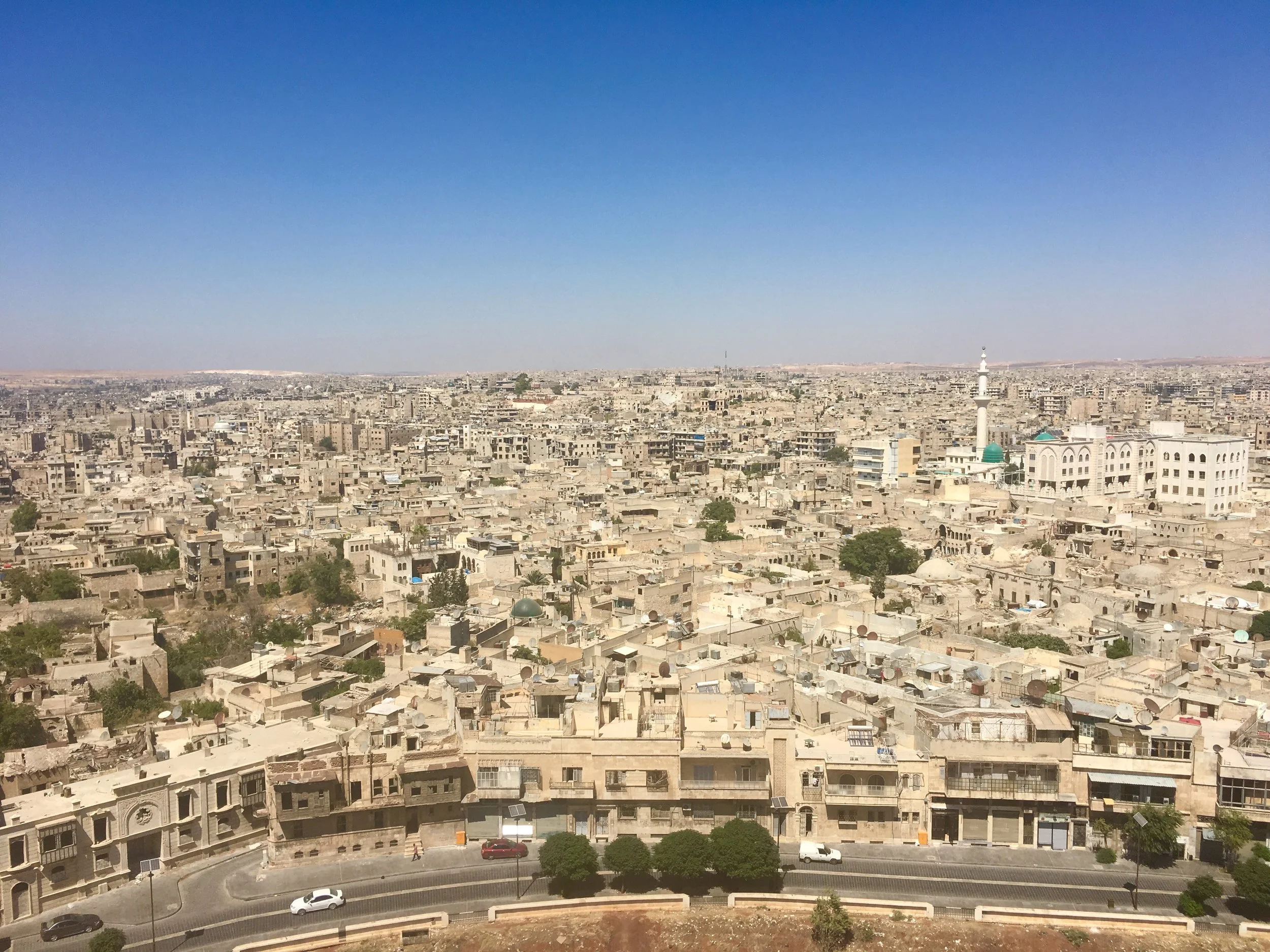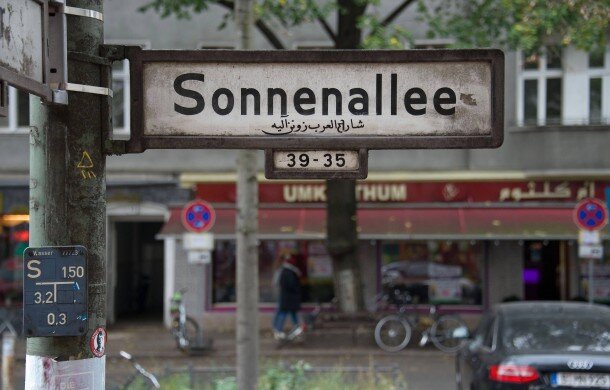“I miss the burning sun of Aleppo. Placing my hand on the stoned walls and feeling the heat with the smell of summer. Cars honking. Syrian spirit. Middle eastern probably. I hate silent streets, I probably got that from life there. It's always flaming with people and nothing is more joyful.”
@womanoftheorient
The harshest days of war seems to be fading away very slowly and life is still very hard but the beauty is progressively coming back. Memories are everywhere, some springing back in physical form – as buildings, as homes – others holding onto the photos and corners of people’s minds, keeping them alive. But you can take a tour through it all.
The Citadel
The Souks
Jdeideh district
Djamilieh
New Aleppos
The Citadel
To completely discover Aleppo, you must go where its heart meets, The Citadel (Qale’et Halab) in the old city. One of the biggest citadels in the world and an immense pride for the people of Halab.
Though you may just be visiting, know that we say you are not a real Aleppian if you don’t visit the site every chance you get. It is magnificent – visit for breakfast and then explore inside. You could do this your entire lifetime and still make new discoveries as you run up the stairs to observe the entire city from up high.
If you needed to boost your energy, the square in front of the citadel offered a vast array of coffee shops and restaurant. Before the war, it was the place to be. The entire square was destroyed and has been rebuilt since, trying to give back to Aleppo, its old atmosphere.
The Souks
If you keep walking around the Citadel, you’ll find Souk Al-Mdineh, one of the oldest and largest souk in the world (1500sqm).
Perhaps what makes the souk so terrific – and after the war, so tragic – is that it holds a deep meaning for every Aleppian, the mother getting her spices, the grandmother bringing treats home from the sweet shops behind the Great Mosque of Aleppo, or the aunt buying fabric and always trying to get the best prices.
Source: Seier
What makes it so authentic, so beautiful?
“It was one of my favorite things to do. Go to souk al-Mdineh in Aleppo, with my mother and aunts. They would get their spices and I fancied the Syrian silver jewelry and the scarves, I still wear them everyday. Then when we got a little older, we would go with my friends and try imitating our parents into getting a lower price. We had all the technics, I still smile thinking about it. Souk al-Mdineh is huge, it has so many alleys and so many parts yet I still have most of them in mind.” Dima (Woman of the Orient)
Suddenly, you get caught by an incredible smell. Aleppo is famous for its spices and “Souk el ‘Aterin”, has a story of its own, very linked to the culinary heritage of the city.
“Souk El Saboun,” or “the soap souk”, an important part of a city famous for its soap, called “Saboun Halab” or “Saboun Ghar” translating to “Laurel Soap”. It is made out of olive oil, lye and most importantly, laurel oil – the substance that defines its quality: the higher the concentration, the better. Breathe it deeply.
Source: @womanoftheorient
Because it’s handmade, Inhale the richest memories and stories of Aleppo through its smell. And, like wine, the older the soap gets, the better it is. Aleppo Soap is one of the oldest soaps in the world, if not the oldest.
In older times, Aleppo soap was the cleaning product used for everything, from body, to hair and laundry washing. It is considered magic to this day – the answer to any stain, to stronger hair, to softer skin. It was the favorite gift everyone was getting when visiting friends and family living abroad.
Beyond souks, other markets, Aleppo’s Khans and old Aleppo hold great history. Your shopping transforms in a journey every single time you visit.
In Khan Al-Shuneh, a separated part of the souk in front of the citadel, there used to be artisans weaving on the loom. This is precision is to cherish. Relish. Admire. Despite the challenges, we have hope. Before you visit, you must meet the city craft heritage.
The artisans who have been working in it for decades. They were and are a part of it, they were and are it. But there is much work to do to save what was lost.
Syrian heritage lies deeply in the passion of Artisans who have within their hearts to carry the traditions.
One of the biggest tragedies that happened in Syria during the war was in September 2012 when a big part of the souk was set on fire, destroying centuries and centuries of history.
Source: World Monuments Fund
Aleppo’s ancient city is also very famous for its Hammams. These are not only places of cleansing but also gathering. Family. Cooking. Togetherness. Yes, in Aleppo, the Hammam was like a social club, to discuss all kinds of businesses. After the Citadel, explore Hammam Al-Nahhasin, built around the XII century and located inside Souk Al-Mdineh. Keep in mind – men and women go at different times, and there are also special hours to visit.
Source: Pascal Meunier (2000)
Move from cleansing to healing. Down the ancient city, near Bab Qinnisrin, lays Bimaristan Argun Al Kamili. Built in 1354 by Argun Al Kamili, a representative to the Mamluk Sultan, the building, one of the oldest hospital in the islamic world, was a mental health asylum (“Bimaristan” means “hospital” in Persian). Throughout the property, you’ll find fountains at the heart of every area. It was once believed the sound of the water fountain streaming helped calming and healed the patients.
Imagination is an antidote to the destruction this city has experienced.
Let the city speak to you through what’s missing, and what is being recovered: Bab Al-Faraj, “The Gate of Deliverance”, was demolished in 1904, with a renovation program on its way. Bab Al-Faraj is mainly now the name of key landmarks of Aleppo: Bab Al Faraj square with its clock tower built around 1898.
Curious? Learn where Aleppians learn. Right in front of Bab Al Faraj, The National Library of Aleppo was built in 1930 and opened in 1945. A symbol and sanctuary for the mind.
Jdeideh district
Source: @womanoftheorient
Jdeideh District, one of the oldest areas of Aleppo, lays outside of the historic walls of the ancient City. Its corners intrigue…old narrowed streets and alleys, old Arab-styled houses and mansions as Beit Ghazaleh, churches and jewelry shops, especially silver jewelry shops. In this mostly Christian district, you’ll meet many of Aleppo’s most significant churches as St Elia Church situated on Farhat Square. In Jdeideh, Al Hatab Square is the heartbeat, the center. Though it’s sprinkled with silver jewelers, hotels, restaurants and coffee shops, the war has deeply damaged the area, Al Hatab Square feeling the devastation most acutely.
Forty Martyrs Cathedral
The Armenian Apostolic church, located in the old Christian quarter of Jdeydeh, is a significant landmark for the Armenian community of Aleppo. Indeed, the 15th c building is one of the oldest and still active churches through all the Armenian diaspora and the city of Aleppo. After being fully destroyed in 2015, the Cathedral was renovated thanks to the financial participation of 150 000 people and reopened in 2019.
With several centuries of presence in Syria, Armenians are fully part of the city. To the first households, installed in Aleppo for business, the community grew substantially after the 1915 Armenian genocide. Fleeing Ottoman massacres, more than 60,000 Armenians found a safe haven in the city. They quickly integrated the local life specializing in trade and crafts .With a strong network of Armenian schools, education remained a key factor to preserve the Armenian language and identity.
As you continue, meet Sahet Saadaallah Al-Jabri, a square named after Saadallah Al-Jabri, a man who served twice as Prime minister of Syria in the 40’s. Relish being at the center of some of Aleppo’s most moving relics. Reach many different streets since this square sits in between the road taking you to Azizieh , the public garden and the ones taking you to the old city and Djamilieh. As it used to be surrounded by many hotels, memories of previous visitors whisper around.
Source: @aleppototheworld
The public garden Al Hadiqa el Aameh vibrates with memories of Aleppo at its best: older people used to walk around, reminiscing about old memories, feeling nostalgic, showing the place to their grandchildren. Indeed, this place was always filled with grandparents and their grandchildren, a garden fertile for every generation.
Every corner of this city teaches you how culture is central in the city. A perfect example is Omnia, a library that sold books and school materials. It became a ritual: Every end of August, parents and their children used to gather here, buying what they needed for school.
Djamilieh
This area is the city’s main Jewish street. Even though the Jewish community has vanished, Syrian Jews used to live in Djamilieh – and if you explore today, you can still find a synagogue. The Jewish Aleppian community found a new home in several spots of the world and mainly in New York. As early as the 1930’s, several Jewish families from Aleppo settled on Lower Manhattan to recreate a“Little Syria. They lived a second exile by massively leaving Manhattan for Gravesend, Brooklyn. If in NYC, you must visit Mansoura, authentic aleppian pastry in the Big Apple.
M7atet Baghdad , Baghdad station is the railway station of Aleppo. Locals will tell you about journeying here to reach Latakia, the closer coastal city, during spring and summer. The journey was always long, but well worth it. In order to pass the time, children used to make up songs out of the names of the cities we passed by on the road. Can you hear the whir of the trains and passengers? Like its history and headlines, the memories of this city are everywhere.
You can feel the layers of this city. Aleppo is very well known for its multi-cultural, multi-ethnic and multi-religious identity. Here you’ll meet Arabs, Assyrians, Chaldeans, Armenians, Kurds, Circassians.... Together all thrive and respect our city’s rich tapestry, and while heritage is a source of pride, keep in mind that it is considered rude to ask about someone’s religion as in all Syria in general.
Feel this coexistence through its greatest symbol: Jame3 el Tawhid ,The Mosque of Tawhid, situated in the center of the city. It has four minarets and around each minaret lays a Church. And it frequently happens that when the muezzin calls for prayer, the bells of the churches ring simultaneously. Listen close as the most beautiful melody of Aleppo covers the city.
If you wander towards the souk, you’ll find the Jame3 al Kabeer, The Great Mosque, an Omayyad Mosque in the old city, the biggest and oldest mosque in Aleppo. Every Aleppian has visited it once whether Muslim or not. Sadly, it has been deeply destroyed during the war and its minaret has fallen. It is hard to explain how hurtful this is to the history of Aleppo and its citizens. But the dust settles. Restoration begins. This mosque is living, breathing, just like us.
Praying. Practicing. Remembering. Changing. Enduring. The Great Synagogue of Aleppo renovated by the NYC diaspora in 1992 is still standing but remains empty and silent. It used to be home to the “Aleppo Codex” a medieval manuscript of the Hebrew Bible. Local Jewish legend used to say that once the document would leave the city, it will be a sign of the end of the community.
You could continue this journey forever. Aleppo holds many emblematic, historical and beautiful churches along with beautiful mosques and synagogues. No matter your religion, you’re welcome in each of them, always.
You could continue this journey forever. Aleppo holds many emblematic, historical and beautiful churches along with beautiful mosques and synagogues. No matter your religion, you’re welcome in each of them, always.
New Aleppos
Here and there, since decades or just few months, Aleppians have taken a bit of their city on different spots of the world.
Brooklyn- New York
Through times and even before the Syrian Civil war, the once numerous Jewish community of Aleppo has shrunk to find a new home in the busy New York. The "SY" ('“ess-why”), short for "Syrians" are mainly composed of Damascene and Aleppian Jews who migrated in the early 1900's as in 1990's once Hafiz Assad allowed Syrian Jews to leave Syria under the condition of not going to Israel. Affluent businessmen or religious dignitaries, Aleppian Jews (with other Syrian Jews) are more than 75.000 in New York. A community in the community as they were often called " Arabische Yidden" (the Arab Jews in Yiddish) by the majority Ashkenazim New-York Jews. Until now there is still a notable difference between "Halabi SY" (Aleppian Jews) founding themselves more knowledgeable and "Shami SY" (Damascene Jews) but both communities follow one of the most conservative rule, the “Edict” making intermarriage (with non Jewish) impossible: converts and children of converts are not accepted. The community was described in the theater play “Syria, America’ by Lance Crowfoot-Suede'. The production takes place in a Syrian Jewish neighborhood in Brooklyn, where four childhood friends are forced as adults to choose between their homosexuality and their community, leading to an unforgivable betrayal.
Source: Magen David Synagogue
Berlin- Germany
The latest war pushed massively Aleppians to find safer places for them and their family. More than a million Syrians settled in Germany to start a new life. In Berlin, the heart of the community lays in Sonnenallee, an area between hipster Neukölln and Kreuzberg. The district which used to be split by the Berlin Wall is also a traditional immigrant neighborhood, with Turkish and then Arab population. After welcoming Lebanese and Palestinian immigrants fleeing Lebanese Civil war in the 1980’s Sonnenallee was nicknamed “Little Beirut” and has now became “Arab street”. The area is the best place to find Syrian and Middle Eastern food while drinking hot tea with sheesha.
Source :FAZ





















